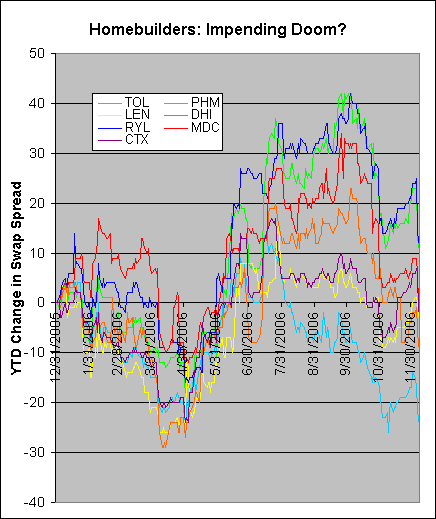On Wednesday, Toll Brothers released earnings, posting a 44% decline in net profit. CEO Robert Toll expressed some optimism, saying that "we may be seeing a floor in some markets..." Toll was panned in some spots for their optimism.
But those who bet on corporate solvency for a living are betting with the home builders. I took a look at YTD change in asset swap spread for the 7 major investment-grade home builders. In each case I used a 10-year issue. The source is Merrill Lynch. A positive number means the bonds have increased in spread, indicating the market thinks there is more risk in the name. A negative number is the opposite, the market thinks the company is a safer bet today than at the beginning of 2006.
Toll Brothers (Baa3/BBB-): +11bps
Pulte Homes (Baa3/BBB): -24bps
Lennar (Baa2/BBB): -3bps
DR Horton (Baa3/BBB-): -9bps
Ryland (Baa3/BBB-): +12bps
MDC (Baa3/BBB-): No Change
Centex (Baa2/BBB): -2bps
So we have two wider, four tighter and one flat. None have moved in a big way YTD, although all are much tighter than where we were in June. Here is a graph of the net change over the course of the year in each.
Here is some perspective. Based on a 6% coupon and 40% recovery, a 10bps widener implies a 1.5% increased chance of default over the course of the next 10-years. So the worst performing home builder in this group, according to the bond market, has only a slightly higher probability of defaulting today than it did at the beginning of the year. Further, most home builders have improved in credit strength in 2006.
What does this say about the larger economy. Maybe not too much. The bears will tell you that housing will drag the economy down because of reduced consumer spending via cash out refis as well as reduced construction-related employment. Credit spreads on home builders aren't saying anything about the cash out refi effect. The bond market is saying that home builders will be able to maintain positive cash flow, but that could be because of a massive reduction in spending.
What the credit spreads are telling you is that the bottom is near. If home builders were going to be unable to sell off their inventory and/or take large losses on inventories, spreads would be wider. If there were to be no market for newly constructed homes for several years, spreads would be wider. The credit market has neither of these views.
Friday, December 08, 2006
Homebuilders headed for doom? Bond market doesn't think so.
Subscribe to:
Post Comments (Atom)



5 comments:
Isn't this the same group of trader who are betting on three rate cuts out of the Federal Reserve next year? Now that mortgage lenders are rethinking their sub-prime lending, the pool of buyers for homes in inventory is even smaller than last year.
Given the size and geographic diversification of these builders, they are not likely to default on the bonds. But will they still be investment grade in two years?
Do you buy bonds because because you enjoy the speed and sense of danger in a roller coaster ride?
If not I suggest there less tempestuous companies to lend your money to.
I agree that home builder bonds don't look like much of a buy. That's because there seems to be little upside. Any BBB-rated bond with a spread inside of +150 has very little upside.
My point was more about how the market and the pundits are at odds. I'd rather bet on the market than the pundits.
The Housing sector Bonds foreshadowed the strong Housing stock rally that started mid-summer ... the question now is , was that short-covering and/or some deep value buyers ??? and where do we go from here ??
Hey Tom, that was a great spread chart. Where did you get the spread data to build the chart? Bloomberg?
Merrill Lynch index data. Its available on Merrill's institutional research site if you have access to that. I think we can all agree that index data is an imperfect measure of bond spreads, but within the investment-grade world, I think its damn close.
Post a Comment